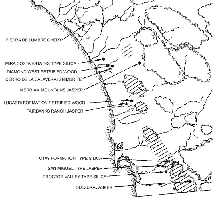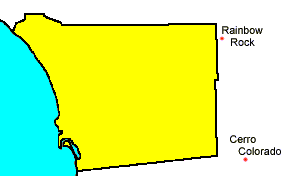Cryptocrystalline Silica
Cryptocrystalline silica — rock composed of extremely fine silica (quartz) crystals — is known by a variety of different names (generally based on differences in translucence, color, texture, or presumed geological origin) including chert, chalcedony, jasper, agate, flint, and petrified wood. Although cryptocrystalline silica rarely makes up a large proportion of the material in San Diego County lithic assemblages, it was evidently valued for its flaking properties and was distributed widely.
Models for prehistoric lithic material exploitation and exchange require that materials from different source areas be distinguished and that those source areas be identified. The importance of basing broader cultural inferences on reliable information concerning source areas for cryptocrystalline silica has been illustrated in the controversies over the local or exotic origin of the jasper at the Tomato Springs Site (ORA-244) in Orange County (Cottrell 1985; Koerper et al. 1987; Shackley 1987).
 Notable attempts to identify and distinguish the sources of the cryptocrystalline silica found in San Diego County assemblages have been made by Douglas M. Flower, Darcy Ike, Linda Roth, and Susan Varner (1979), Richard H. Norwood (1979, 1982), and Andrew R. Pigniolo (1992, 1994). Pigniolo considered in detail the distinctiveness of material from the Piedra de Lumbre source on Camp Pendleton, which he found to be distinguishable from other local materials on the basis of each of three techniques: macroscopic observations, petrographic thin sections, and x-ray fluorescence trace element analysis.
Notable attempts to identify and distinguish the sources of the cryptocrystalline silica found in San Diego County assemblages have been made by Douglas M. Flower, Darcy Ike, Linda Roth, and Susan Varner (1979), Richard H. Norwood (1979, 1982), and Andrew R. Pigniolo (1992, 1994). Pigniolo considered in detail the distinctiveness of material from the Piedra de Lumbre source on Camp Pendleton, which he found to be distinguishable from other local materials on the basis of each of three techniques: macroscopic observations, petrographic thin sections, and x-ray fluorescence trace element analysis.
| Type | Other Designations | Description |
| Cerro de la Calavera | — | Opaque; grey, yellow-grey, green-grey, black; angular quartz grains |
| Diamond West | Norwood Silica 5 | Petrified wood; opaque to translucent; tan, brown, white, grey; good quality |
| Dulzura | — | Opaque; yellow-brown to red; probably poor quality |
| Fairbanks Ranch | Norwood Silica 3 | Opaque; red; veins of white quartz and chalcedony; poor quality |
| Lucardi Formation | — | Petrified wood; opaque to translucent; pink, tan, brown; good quality |
| Merriam Mountains | Norwood Silica 4 | Opaque; maroon, dull red; imperfections and fractures common; poor quality |
| Miracosta | Norwood Silica 2; Flower et al. Chalcedony 2 | Opaque; tan, brown, white; vugs and fractures common; poor quality |
| Otay Formation | — | Opaque to translucent; brown, white, grey |
| Piedra de Lumbre | Norwood Silica 1 (“Bonsall Type”); Flower et al. Chalcedony 1; True, Waugh, etc. ignimbrite | Opaque; tan, cream, brown, pink; large subangular quartz grains diagnostic; good quality |
| Proctor Valley | Cf. Norwood Silica 7 (“Encanto type”) | Opaque to translucent; commonly white but also orange, red, brown; poor quality |
| San Miguel | — | Opaque; dull red |
Cryptocrystalline silica sources in western San Diego County, based on Pigniolo 1992.
Pigniolo investigated the frequency of Piedra de Lumbre artifacts in some 80 archaeological sites in San Diego, Orange, and Riverside counties. To compare the frequencies, he used a compound statistic, the sum of the percentages by count and by weight of Piedra de Lumbre materials within each lithic assemblage. He drew several conclusions from the study:
— The dropoff in the frequency of Piedra de Lumbre artifacts with distance from the source seemed to support, in general, the “law of monotonic decrement.”
— The distribution pattern seemed to be consistent with a system involving primarily direct procurement rather than exchange.
— The ethnographic boundary between Luiseño and Kumeyaay territories did not significantly affect the movement of the material.
— Chronologically, the exploitation of Piedra de Lumbre material appeared to have been fairly high during the Paleoindian (San Dieguito) period, consideraby lower during the Archaic period, and then high once again during the Late Prehistoric period.
 Fine-grained, silica-rich toolstone, commonly termed “wonderstone,” is also reported from two prehistoric quarry areas near San Diego County’s eastern border: Rainbow Rock in northwestern Imperial County, and Cerro Colorado in northern Baja California (Eckhardt and Porcayo 2013; Pigniolo 1995). Archaeological specimens that visually seem to match the Rainbow Rock source have been reported from sites in Fallbrook and San Marcos, in western San Diego County.
Fine-grained, silica-rich toolstone, commonly termed “wonderstone,” is also reported from two prehistoric quarry areas near San Diego County’s eastern border: Rainbow Rock in northwestern Imperial County, and Cerro Colorado in northern Baja California (Eckhardt and Porcayo 2013; Pigniolo 1995). Archaeological specimens that visually seem to match the Rainbow Rock source have been reported from sites in Fallbrook and San Marcos, in western San Diego County.
PROSPECTS
Future archaeological investigations may be able to identify reliable macroscopic and chemical signatures for cryptocrystalline silica derived from various local sources. They may identify geographical and chronological patterns in the frequencies of different varieties, and they may interpret such patterns in terms of direct quarry exploitation or exchange, ethnic boundaries, and te